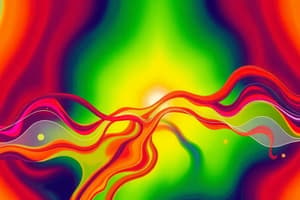Podcast
Questions and Answers
What does Hess's Law state about the enthalpy change for a reaction?
What does Hess's Law state about the enthalpy change for a reaction?
- It is the same regardless of the pathway taken. (correct)
- It is always positive.
- It can only be calculated by experimental methods.
- It varies depending on the reaction pathway.
Which equation correctly represents the relationship between heat, work, and internal energy?
Which equation correctly represents the relationship between heat, work, and internal energy?
- $ Delta H = q - w$
- $ Delta U = q + w$ (correct)
- $ Delta H = q + 2w$
- $ Delta U = q - rac{w}{2}$
What is the standard enthalpy of formation?
What is the standard enthalpy of formation?
- Enthalpy change when one mole of a compound forms from its elements in standard states. (correct)
- Enthalpy change when one mole of a gas forms from its elements.
- Enthalpy change under any reaction conditions.
- Enthalpy change when multiple moles form at high temperatures.
Which of the following is NOT an application of thermochemistry?
Which of the following is NOT an application of thermochemistry?
In a thermochemical equation, what does $
Delta H$ represent?
In a thermochemical equation, what does $ Delta H$ represent?
What is the primary focus of thermochemistry?
What is the primary focus of thermochemistry?
Which statement defines a system in thermochemistry?
Which statement defines a system in thermochemistry?
What does the second law of thermodynamics state?
What does the second law of thermodynamics state?
In calorimetry, what does the equation q = mcΔT represent?
In calorimetry, what does the equation q = mcΔT represent?
What characterizes an endothermic process?
What characterizes an endothermic process?
Which type of energy is associated with the motion of atoms and molecules in a substance?
Which type of energy is associated with the motion of atoms and molecules in a substance?
What does the term enthalpy represent in thermochemistry?
What does the term enthalpy represent in thermochemistry?
During which process does heat flow from a system to its surroundings?
During which process does heat flow from a system to its surroundings?
Flashcards
Thermochemistry
Thermochemistry
The branch of chemistry focused on studying energy changes in chemical reactions and physical transformations.
System
System
The part of the universe being studied, like a chemical reaction.
Surroundings
Surroundings
Everything outside the system that can interact with it, like the air around a reaction.
Boundary
Boundary
Signup and view all the flashcards
Kinetic Energy
Kinetic Energy
Signup and view all the flashcards
Potential Energy
Potential Energy
Signup and view all the flashcards
Thermal Energy
Thermal Energy
Signup and view all the flashcards
Enthalpy change ("delta" H)
Enthalpy change ("delta" H)
Signup and view all the flashcards
Heat of Reaction (q)
Heat of Reaction (q)
Signup and view all the flashcards
Hess's Law
Hess's Law
Signup and view all the flashcards
Thermochemical Equation
Thermochemical Equation
Signup and view all the flashcards
Standard Enthalpy Change (ΔH°)
Standard Enthalpy Change (ΔH°)
Signup and view all the flashcards
Standard Enthalpy of Formation (ΔH°f)
Standard Enthalpy of Formation (ΔH°f)
Signup and view all the flashcards
Study Notes
Thermochemistry Overview
- Thermochemistry studies energy and heat in chemical reactions and physical changes.
- It examines energy transfer between a system (e.g., reaction) and its surroundings.
- Key concepts include energy, enthalpy, entropy, and thermodynamics laws.
Key Concepts
- System: The part of the universe being studied (e.g., a reaction).
- Surroundings: Everything outside the system that interacts with it.
- Boundary: Separates the system from the surroundings.
- Kinetic Energy: Energy of motion.
- Potential Energy: Stored energy due to position or composition.
- Thermal Energy: Related to molecular motion.
- Heat (q): Energy transfer due to temperature difference (high to low).
- Work (w): Energy transfer due to an external force moving an object.
Laws of Thermodynamics
- First Law (Conservation of Energy): Energy cannot be created or destroyed, only transferred or transformed.
- ΔU = q + w (Change in internal energy = heat + work)
- +ve q = heat absorbed
- -ve q = heat released
- +ve w = work done on the system
- -ve w = work done by the system
- Second Law: The total entropy (disorder) of the universe increases in spontaneous processes.
Enthalpy
- Enthalpy (H) is a thermodynamic property representing heat content at constant pressure.
- H = U + PV (Enthalpy = internal energy + pressure x volume)
- Change in Enthalpy (ΔH): Indicates heat absorbed or released at constant pressure.
- +ve ΔH = Endothermic (heat absorbed)
- -ve ΔH = Exothermic (heat released)
Calorimetry
- Calorimetry measures heat transfer during processes.
- Heat Transfer Equation: q = mcΔT (heat = mass × specific heat capacity × temperature change)
- Heat of Reaction Equation: qreaction = -qsurroundings
Hess's Law
- Hess's Law: Enthalpy change for a reaction is the same regardless of the pathway, as long as initial and final states are the same.
- ΔHoverall = Σ ΔHsteps (overall enthalpy change = sum of enthalpy changes for steps)
Thermochemical Equations
- Thermochemical equations include enthalpy changes (ΔH).
- Example: CH4 + 2O2 → CO2 + 2H2O, ΔH = -890 kJ/mol
Standard Enthalpy Changes
- Standard enthalpy of formation: Enthalpy for forming 1 mole of a compound from its elements in standard states.
- Standard enthalpy of reaction: Enthalpy change under standard conditions (defined temperature and pressure).
Applications of Thermochemistry
- Predicting reaction spontaneity.
- Optimizing energy usage.
- Studying atmospheric reactions.
- Analyzing energy transfer in biological systems.
Important Relationships
- ΔU = q + w
- q = mcΔT
- ΔH = Hproducts - Hreactants
- ΔHoverall = Σ ΔHsteps
Studying That Suits You
Use AI to generate personalized quizzes and flashcards to suit your learning preferences.




